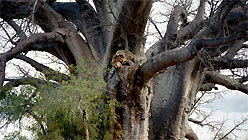Rachel Sussman’s quiet exhibition of just a dozen photos has a very noisy title: The Oldest Living Things in the World. Now on view through January 16, 2011, at the Montalvo Arts Center in Saratoga, the modest show may disappoint those who are expecting to see images of the 2,150-year-old Sentinel Tree in Sequoia National Park or clonal quaking aspens in Utah, which are believed to be some 80,000 years old.
We know about that stuff because we live in the West, so if you want to see those images, visit Sussman’s website — she’s photographed both, plus some rather drab clonal creosote bushes in the Mojave Desert, which are estimated at 12,000 years old. Instead, what we get at Montalvo’s Project Space Gallery are a number of photos from the African desert, brain coral off the coast of Tobago and a close up of some Siberian actinobacteria — photographed at the Neils Bohr Institute in Copenhagen — that’s about 500,000 years old.
The Bohr bacteria is both the oldest thing in the show and the least interesting to look at, proving, perhaps, that taking one’s artistic conceits to their ultimate conclusions doesn’t always result in good art.
In fact, there are several cases in which the artist tosses her artist’s beret aside for the documentarian’s fedora, but the show’s mix feels healthy, creating pace from picture to picture, while bringing those subjects Sussman spends time composing into sharper focus for viewers. The show is smart in both its modesty and its immodest promise.

One of the most compelling photographs is her picture of a yew in Perthshire, Scotland. Thought to be between 2,000 and 5,000 years old, the tree is identified by a Monty Pythonesque wood-frame sign that reads “THE YEW.” Indeed it is, hiding behind a stone wall that consumes fully half of Sussman’s frame. As for the yew, its foliage is so dense that we can’t see the tree for the forest. Oddly, I wanted to go there and see it for myself.




